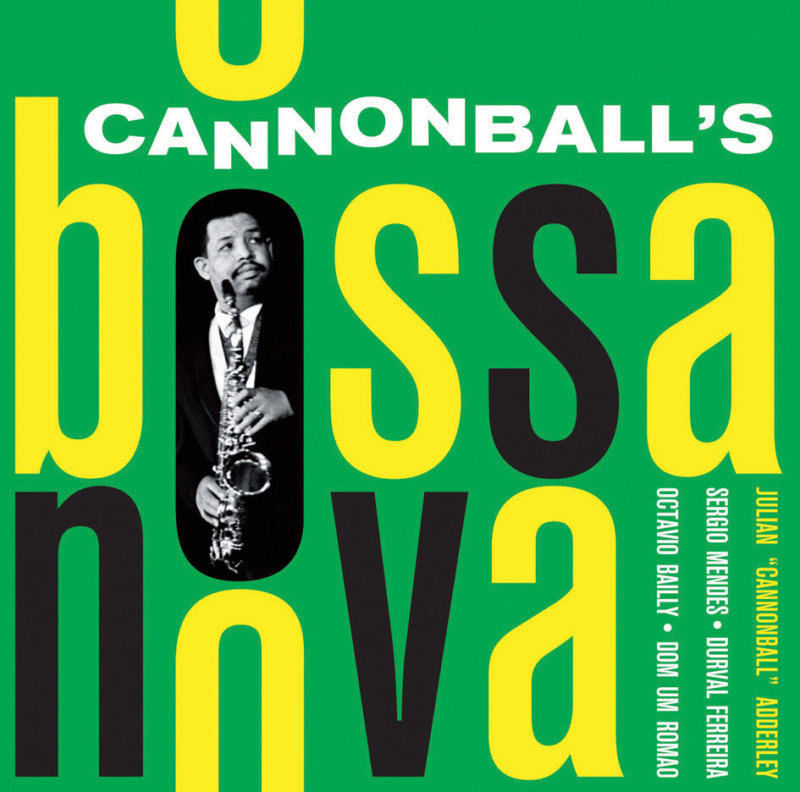|
|
| Discography |
| About Julian |
| About Site |
Since Dec,01,1998
©1998 By barybary

![]()
 |
Other Reissue
|
|
|
|
|
||
JULIAN "CANNONBALL" ADDERLEY, alto sax
Sergio Mendes, piano;
Durval Ferreira, guitar;
Octavio Bailly, Jr.,
bass;
Dom Um Romao, drums;
Pedro Paulo, trumpet;
Paulo Moura, alto sax.
(Paulo and Moura do not play on Clouds, Corcovado
and Groovy Samba.)
|
Recorded in NYC , December 7 & 10 , 1962 |
SIDE 1
1. Clouds (4:49) (Durval Ferreira)
2. Minha Saudade (2:20) (Joao Donato) (ASCAP)
3. Corcovado (6:42) (Antonio Carlos Jobim) (ASCAP)
4. Batida Diferente (3:25) (Durval Ferreira and
Mauriejo Einhorn) (ASCAP)
SIDE 2
1. Joyce's Samba (3:10) (Ferreira and Einborn)
2. Groovy Samba (4:58) (Sergio
Mendes) (ASCAP)
3. 0 Amor Em Paz (Once I love) (7:46) (Antonio
Carlos Jobim) (ASCAP)
4. Sambop (3:32) (Ferreira and Paulo Moura)
On Landmark Reissue LLP 1302 , Two alternate takes was added
side 1 track 3. Clouds (2:40) (Durval
Ferreira)
side 2 track 3. Corcovado (5:35) (Antonio Carlos
Jobim)
Liner notes from the Original LP issued in 1962
|
This album, which uniquely combines
the talents of an outstanding jazz star with those of an exciting
group of young Brazilians, is not only a most fascinating
presentation of that irresistible Latin music known as
bossa nova. It is also something truly
unusual. From the evidence on this record - beginning with Cannonball's first soaring notes on the haunting Clouds - it would almost seem that bossa nova was created to be played by Adderley. Or at least to be played by him with the accompaniment he has here. And the key to the success of this intriguing merger is - from both directions - jazz. One notable feature of the vast popularity of bossa nova in this country has been the way in which it has been adopted by jazz artists, who have been its most effective exponents. On the other hand, as musicians who have toured in South America have discovered, the recent influence of our jazz on the music of that continent (and especially in Brazil) has been extremely strong. One result of this has been the emergence of such a group as the highly jazz-indoctrinated Bossa Rio. So, one night at Birdland when I found Cannonball surrounded by a half-dozen eager young men, they turned out to be not (as it first seemed) local fans, but Brazilian musicians. The Bossa Rio had come to New York only for a single concert appearance, but their enthusiasm for his music led Cannon to quickly arrange for a private hearing of their music. He was immediately taken with the idea of recording with them, a suggestion that they welcomed wildly. Adderley's approach here is to deal entirely with Brazilian material - he swiftly rejected as artificial any thought of twisting either pop standards or jazz originals into a bossa nova format. However, jazz is obviously and happily implicit throughout the album - not only because of the presence of Cannonball, but also because of the musical nature of the Bossa Rio group, which includes a drummer who had a lot of New York drummers talking to themselves and is led by a pianist who would seem to have done a lot of valuable listening to Horace Silver discs (and who kept asking me for copies of Bill Evans albums). Thus the two elements involved in this merger found their highly effective common meeting ground: Adderley moving towards the young Brazilian by utilizing their kind of material (specifically, five of the numbers are partly or entirely written by members of the band), and they moving towards him through their admiration for him and through their own rather remarkable jazz spirit and ability. It comes closest to a 'pure' jazz feeling on a tune like Mendes' soulfully swinging Groovy Samba; it reaches a universally appealing lyricism on selections like guitarist Ferreira's Clouds and Antonio Carlos Jobim's Corcovado. And at all times it offers thoroughly enjoyable examples of the adventure described by the title of another of Ferreira's compositions: an intriguing encounter with a "batida differente" - a truly "different beat".
|


















